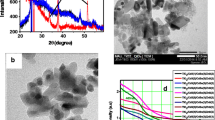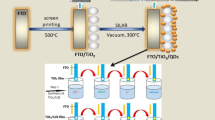Abstract
Quantum dots sensitized nanocrystalline TiO2 solar cells (QDSSCs) are promising third-generation photovoltaic devices. In comparison with conventional dye-sensitized solar cells (DSSCs), the efficiency of QDSSCs is still very low (about 3%). In this paper, the electrochemical impedance spectroscopy technology has been adopted to investigate the quasi-Fermi level and the carrier dynamics of the colloidal CdSe QDs sensitized TiO2 eletrode with S2−/S − x redox electrolytes and the series resistance of the QDSSCs. In comparison with the conventional DSSCs with Γ −3/Γ − as redox electrolytes, the energy difference between the conduction band edge and the quasi-Fermi levels of the TiO2 films (or the Fermi levels of the redox electrolytes) in QDSSCs has been decreased by about 0.3 V, resulting in the decrease of V oc by this value. The increases of the electrolyte diffussion resistance and the charge transfer resistance between Pt counter electrodes and S2−/S − x redox electrolytes were attributed to the decrease of the fill factors. However, the electron lifetime and electron diffussion length for QDSSCs are longer than those for DSSCs due to the retardation of the electron recombination by the adsorbed cysteine at the surfaces of the TiO2 films. It is indicated that electron recombination at the TiO2/electrolyte interface is not the main reason for the lower J sc of the colloidal QDs sensitized QDSSCs. Improving light harvesting efficiency and photoelectron injection efficiency should be considered in the future for such kind of QDSSCs.
Similar content being viewed by others
References
O’Regan B, Grätzel M. A low-cost, high-efficiency solar-cell based on dye-sensitized colloidal TiO2 films. Nature, 1991, 353: 737–740
Bisquert J. Physical electrochemistry of nanostructured devices. Phys Chem Chem Phys, 2008, 10: 49–72
Cao Y, Bai Y, Yu Q, Cheng Y, Liu S, Shui D, Gao F, Wang P. Dye-sensitized solar cells with a high absorptivity ruthenium sensitizer featuring a 2-(hexylthio)thiophene conjugated bipyridine. J Phys Chem C, 2009, 113: 6290–6297
Ning ZJ, Tian H, Triarylamine: a promising core unit for efficient photovoltaic materials. ChemComm, 2009, 5483-5495
Kamat PV. Quantum dot solar cells. Semiconductor nanocrystals as light harvesters. J Phys Chem C, 2008, 112: 18737–18753
Yu W, Qu LH, Guo WZ, Peng XG. Experimental determination of the extinction coefficient of CdTe, CdSe, and CdS nanocrystals. Chem Mater, 2003, 15: 2854–2860
Nozik AJ. Quantum dot solar cells. Physica E, 2002, 14: 115–120
Klimov VI. Mechanisms for photogeneration and recombination of multiexcitons in semiconductor nanocrystals: Implications for lasing and solar energy conversion. J Phys Chem B, 2006, 110: 16827–16845
Diguna LJ, Shen Q, Kobayashi J, Toyoda T. High efficiency of CdSe quantum-dot-sensitized TiO2 inverse opal solar cells. Appl Phys Lett, 2007, 91: 023116
Giménez S, Mora-Seró I, Macor L, Guijarro N, Lana-Villarreal T, Gómez R, Diguna LJ, Shen Q, Toyoda T, Bisquert J. Improving the performance of colloidal quantum-dot-sensitized solar cells. J Nanotechnology, 2009, 20: 295204
Mora-Seró I, Giménez S, Moehl T, Fabregat-Santiago F, Lana-Villareal T, Gómez R, Bisquert J. Factors determining the photovoltaic performance of a CdSe quantum dot sensitized solar cell: the role of the linker molecule and of the counter electrode. J Nanotechnology, 2008, 19: 424007
Wang Q, Pan D, Jiang S, Ji X, An L, Jiang B. A solvothermal route to size- and shape-controlled CdSe and CdTe nanocrystals. J Cryst Growth, 2006, 286: 83
Mora-Seró I, Giménez S, Fabregat-Santiago F, Gómez R, Quin S, Toyoda T, Bisquert J. Recombination in quantum dot sensitized solar cells. Accounts Chem Res, 2009, 42: 1848–1857
Fabregat-Santiago F, Bisquert J, Garcia-Belmonte G, Boschloob G, Hagfeldt A. Impedance spectroscopy study of the influence of electrolyte conditions in parameters of transport and recombination in dye-sensitized solar cells. Sol Energy Mater Sol Cells, 2005, 87: 117–131
Bisquert J, Garcia-Belmonte G, Fabregat-Santiago F. Doubling exponent models for the analysis of porous film electrodes by impedance, relaxation of TiO2 nanoporous in aqueous solution. J Phys Chem B, 2000, 104: 2287–2298
Bisquert J. Theory of the impedance of electron diffusion and recombination in a thin layer. J Phys Chem B, 2002, 106: 325–333
Fabregat-Santiago F, Bisquert J, Cevey L, Chen P, Wang M, Zakeeruddin SM, Grätzel M. Electron transport and recombination in solid state dye solar cell with spiro-OMeTAD as hole conductor. J Am Chem Soc, 2009, 131: 558–562
Bisquert J. Chemical capacitance of nanostructured semiconductors: Its origin and significance for nanocomposite solar cells. J Phys Chem Chem Phys, 2003, 5: 5360–5364
Fabregat-Santiago F, Mora-Seró I, Garcia-Belmonte G, Bisquert J. Cyclic voltammetry studies of nanoporous semiconductors. Capacitive and reactive properties of nanocrystalline TiO2 electrodes in aqueous electrolyte. J Phys Chem B, 2003, 107: 758–768
Bisquert J, Vikhrenko VS. Interpretation of the time constants measured by kinetic techniques in nanostructured semiconductor electrodes and dye-sensitized solar cells. J Phys Chem B, 2004, 108: 2313–2322
Fabregat-Santiago F, Garcia-Canadas J, Palomares E, Clifford JN, Haque SA, Durrant JR, Garcia-Belmonte G, Bisquert J. The origin of slow electron recombination processes in dye-sensitized solar cells with alumina barrier coatings. J Appl Phys, 2004, 96: 6903–6907
Wang Q, Ito S, Grätze M, Fabregat-Santiago F, Mora-Seró I, Bisquert J, Bessho T, Imai H. Characteristics of high efficiency dye-sensitized solar cells. J Phys Chem B, 2006, 110: 25210–25221
Fabregat-Santiago F, Bisquert J, Palomares E. Correlation between photovoltaic performance and impedance spectroscopy of dye-sensitized solar cells based on ionic liquids. J Phys Chem C, 2007, 111: 6550–6560
Author information
Authors and Affiliations
Corresponding authors
Rights and permissions
About this article
Cite this article
Xu, X., Xu, G. Electrochemical impedance spectra of CdSe quantume dots sensitized nanocrystalline TiO2 solar cells. Sci. China Chem. 54, 205–210 (2011). https://doi.org/10.1007/s11426-010-4170-1
Received:
Accepted:
Published:
Issue Date:
DOI: https://doi.org/10.1007/s11426-010-4170-1




